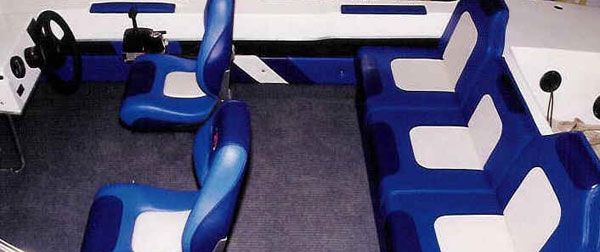Boat cleaning – tops and seats
Article from Sea Magazine & Go Boating, by Carol Albanese
How to clean outdoor fabric
Dear Mermaid;
We are very happy with our new Bimini and vinyl windows; however, I see around the stitching there is a little mildew. It is hard to remove because of the stitching and I really don’t know what to use to clean it. Could you tell us how to care for Sunbrella® Fabric and our vinyl seats so we can extend the life of our boat top and seats?.
Thanks Joe from Long Beach, CA.
How to Keep Your Canvas Like New
Sunbrella® offers maintenance tips for covers and tops. The following tips can be used on most fabrics made for outdoors use. Always test any cleaning product on an inconspicuous spot before using on fabric & vinyl. Glen Raven Mills, manufacturer of Sunbrella® fabrics released their “maintenance” suggestions, explaining how to maintain their fabric.
To avoid having to clean and re-treat Sunbrella®, hose it off monthly. The fabric will not support the growth of mildew, but if dirt or soap is allowed to remain on the fabric for any length of time, it will support mildew growth. Mold spores enjoy nothing more than to dine on left over soap. It thrives in damp climates, no matter how great the fabric is you must change the environment in order to avoid the problems that are specific to your boats location. Clean the fabric with a mild soap. Mer-maids’ has a cleaner that was tested and approved for use on Sunbrella® by the manufacturer Glen Raven Mills; it displays the Sunbrella® logo on our label. This helps customers feel “at ease” knowing there are gentle, affective cleaners they can safely use without harming the fabric. No matter what cleaner you choose be sure it is approved for use on the fabric or the surface you are going to clean. Using too a strong cleaner can damage delicate surfaces. As you know it is expensive to have them replaced.
Ok, roll up your sleeves; it’s time to go to work. Rinsing first is important; the water soaks into the fabric acting like a conduit, spreading the soap evenly over the area you’re cleaning.. If you applied the cleaner without rinsing first, the soap will soak into the fabric unevenly, not a good use of time or soap.
You rinse your car before cleaning it, don’t you? The same principal applies with most things you clean. Start with a bucket of warm water (if it is possible to use) and the recommended amount of cleaner. Apply the cleaner using a dense, soft brush. Scrub and let the cleaner sit for about 5 or 10 minutes depending on how warm the day is. Don’t let the soap dry! Rinse well, repeat steps again if you miss a spot or don’t get the results you wanted the first time.
Stitching around windows seems to be a place where dark stains and mildew take hold. It is especially important to let the cleaner have a chance to loosen the dirt; don’t be in a hurry to rinse the area. Again, use a soft dense brush; old toothbrush, fingernail brush or vegetable brush; we now offer our favorite brush; it is available on our site. If you still see mildew, give it an extra scrub if needed.. Rinse well!
Never use a power washer on fabric! You might not see the damage but it is there. Power washing will stretch and weaken the fabric; you will also remove the waterproof treatment. Dirt and grime will fill in where threads use to be. Power washing will shortened the life of your fabric!
If heavy stains remain, Glen Raven Mills recommends using a mixture of 4 ounces of chlorine bleach in a gallon of water; apply the bleach mixture using a brush; let sit a few minutes; always rinse well! The bleach can harm the stitching if a thorough rinsing isn’t complete.
My favorite bleach is a colorfast bleach; it is an oxygenated bleach and unlike chlorine bleach will oxydize away (it does not continue to weaken fabric) Water temperature affects the bleaching rate of oxygen bleaches. Hot water accelerates the bleaching action – as water temperature decreases, exposure time must be increased substantially, use as directed and rinse well
Sunbrella® fabric is treated with a fluorocarbon finish, which enhances water repellency. This treatment is designed to last for several years if the fabric is cared for properly. After several cleanings, the finish will lose some of its repellency. Boost water repellency with a topical waterproof treatment, but use a product that still will allow the fabric to breathe. Glen Raven Mills has approved a waterproofing product, 303 High Tech Fabric Guard, which can restore water repellency to near-original state while still allowing Sunbrella® fabric to breath. The product protects against oil-based stains and has UV inhibitors to protect the fabric from sun damage. There are other fabric waterproofing products, read the labels to make sure it is waterproof for fabrics.
Vinyl Seats and other outdoor fabric.
Treat your seating just like the boat top; the same cleaning steps apply. Seats have to stand up to some heavy abuse. Fun loving people who just applied suntan lotion will use your seats. They eat and drink, spilling mustard, juice (hopefully not grape juice) and a whole host of gastronomical delicacies. It is doubly important to take care of spills when they occur. Never use a powdered cleaner (Ajax, or?). You will take the first layer off the vinyl using abrasive cleaners, but that’s another story. Put a towel down when those sun bunnies are using suntan lotion and sitting on your seats, the towel will provide a barrier from almost everything.
An extra bonus when using a towel will be protecting both your friends & family from burning their legs, also the sun can’t damage your vinyl if it can’t get to it!
Happy & Safe Boating….
Carol Albanese (Head Mer-maid®)
www.mermaid.com mermaid@mermaid.com 800 878 1492







